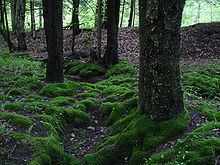Fog
Fog, kent forbye as moss, is sindry wee, saft plaunts that's 1–10 cm (0.4–4 in) lang for ordinar, tho some species is mair muckle. Thay growe for ordinar near thegither in wee busses or basses in dunk, urie or shady airts. Thay dinnae hae flouers or seeds, an thair aefauld leafs kivers the shilpie stalks. At certain times fog brings furth spore cods thit micht kythe as beak-like cods hoven alaft on shilpie stalks.
| Fog | |
|---|---|

| |
| Clumps o fog on the grun an base o trees in the Allegheny Naitional Forest, Pennsylvanie, Unitit States | |
| Scientific classification | |
| Kinrick: | Plantae |
| Clade: | Embryophytes |
| Diveesion: | Bryophyta Schimp. sensu stricto |
| Clesses[2] | |
| Synonyms | |
| |
Fogs is aften mistaen for crottle, a kynd o fungus thit bides simbiotically wi algae or cyanobacteria, acause thair appearance is similar.
Evolution
eeditFog isnae weel kent in the fossil record acause thir cell waas is sae saft. Definite fossils o earlie fogs is kent frae the Permian period, wi som fossils thocht tae be fogs frae the Carboniferous[3].
References
eedit- ↑ Hubers, M.; Kerp, H. (2012). "Oldest known mosses discovered in Mississippian (late Visean) strata of Germany". Geology. 40 (8): 755–758. doi:10.1130/G33122.1.
- ↑ Goffinet, Bernard; William R. Buck (2004). Systematics of the Bryophyta (Mosses): From molecules to a revised classification. Monographs in Systematic Botany. Molecular Systematics of Bryophytes. 98. Missouri Botanical Garden Press. pp. 205–239. ISBN 978-1-930723-38-2.
- ↑ Thomas, B.A. (1972). "A probable moss from the Lower Carboniferous of the Forest of Dean, Gloucestershire". Annals of Botany. 36 (1): 155–161. doi:10.1093/oxfordjournals.aob.a084568. ISSN 1095-8290. JSTOR 42752024.